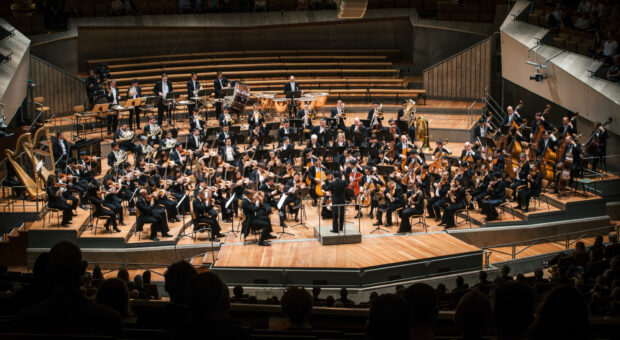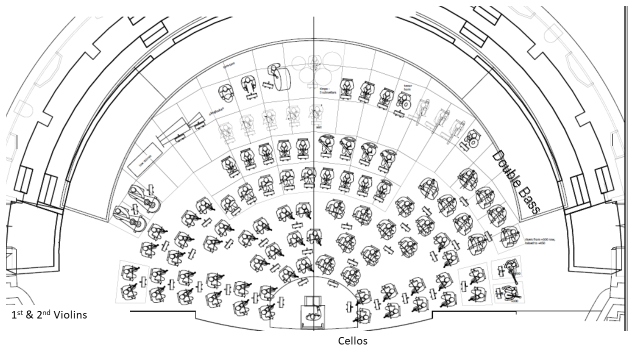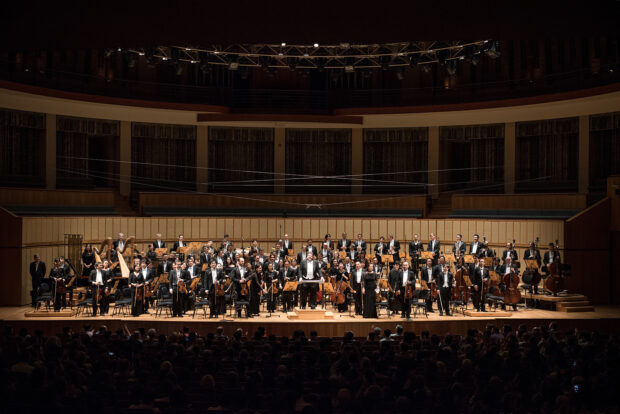
Have you ever sat in a concert and wondered why the violins are all positioned on the left and the cellos on the right, when you clearly remembered the cellos were in the centre of the stage the week before?
Musical Chairs: German, American Seating
Orchestras around the world experiment with different seating arrangements to achieve a particular “sound” for each performance. The choice of seating plan also depends on factors such as the programme and the conductor’s preferences.
Hans Sørensen, the SSO’s Director of Artistic Planning, explains that early orchestras experimented with how they sounded and best played together. What most orchestras refer to as the “German seating” today originated from the general seating plan for the string section around the time of Haydn and Mozart up to Mahler, when the orchestra was arranged to produce an antiphonal effect — that is, to sound as if the instruments, particularly the strings, were “conversing” with one another.
To achieve this stereo-like effect, the violins would be seated on left and right of the stage. Some composers in the 18th to the 19th centuries, such as Beethoven, would keep this seating in mind when writing their music.
Generally, respective sections for German seating plan goes from left to right in this order: First violin, followed by cello, viola, second violin and with the bass behind cello.
Then somewhere around the 1920s, a variation emerged, where the second violins moved over to join the first violins, and were seated together at house left. This meant that the sound of the violins was directed in one direction instead of having the violins come in from the left and right. This seating gained more popularity in America and continental Europe, hence the moniker “American seating”.
At about the same time, over in continental Europe, Berlin Philharmonic and their chief conductor, Wilhelm Furtwangler (1922-1945, 1952-1954), also came up with a variation of the American seating, generally comprising (from left to right): First violin, second violin, cello, viola and the basses behind the viola section.



While orchestral seating may not be everyday conversation fodder for the casual concertgoer, the topic remains one that has provoked countless passionate discussions among conductors and orchestral musicians alike. Hans recommends reading Norman del Mar’s Anatomy of the Orchestra for a deeper look.
Best Seats in the House, You Ask?
As to whether there are really best seats in the house for the best sound, “every concert hall has a favourite spot when we talk acoustics,” said Hans. “In general it’s the stall seats in the middle of the concert hall.”
That said, the Esplanade’s acoustics is “actually very good in most places of the hall compared to other concert halls,” he added.
The sound and the choice of where to sit also depends on the work being performed, whether there is a soloist, if the brass or percussion sections have a big part in the work, if there is a choir, and so on.
Diehard fans will find their own sweet spot after experimenting with different seats, and it’s not uncommon for patrons either to choose different seats for different concerts, or to have a preferred seat when buying tickets for the entire concert season.
We shall leave you, our esteemed audience, to find your favourite seat at the Victoria Concert Hall and the Esplanade Concert Hall. So come watch the Singapore Symphony Orchestra live and listen to hear the difference.
Pick out your next concert experience here:
https://www.sso.org.sg/whats-on